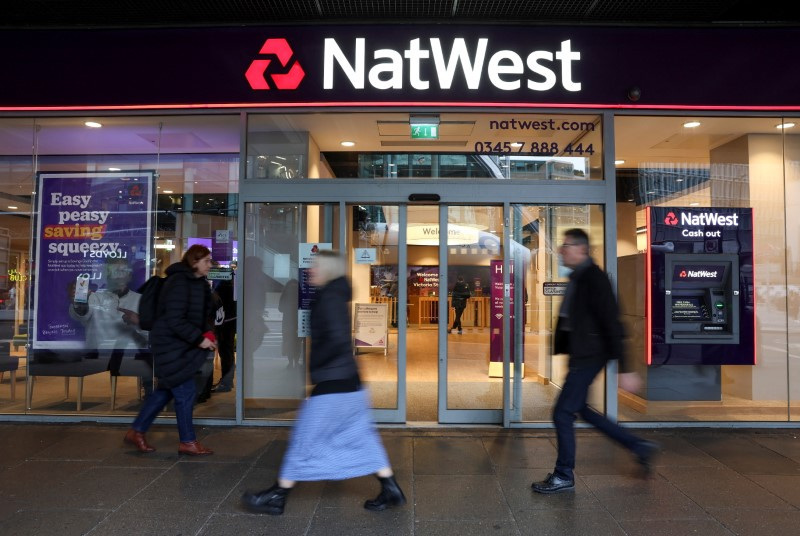By Sinead Cruise
LONDON (Reuters) -NatWest wants to bolster its lending firepower. To do so it plans to cut deals with investors to offload some of its loan risk, to make its capital go further and preserve dividends, executives told Reuters.
The domestically-focused bank, still 19% taxpayer-owned since its 2008 bailout, joins a wave of peers seeking to shed some loan exposure using private deals with investors that can trim regulatory demands for capital by hundreds of millions of pounds.
Robert Begbie, CEO of NatWest's Commercial & Institutional division, said significant risk transfer (SRT) transactions, which the bank had also used in the past, would spur new lending and help maintain shareholder payouts.
SRTs enable a bank to shed lending risk to a third party via derivatives or guarantees that offer protection to the lender in the event of losses on a loan.
Bankers are exploring ways to mitigate new Basel regulations that will impose higher risk weightings on certain loans from 2025, forcing lenders to park more capital against those assets and potentially squeezing access to credit for some borrowers.
"Our Commercial & Institutional business consumes the largest amount of capital across our three customer businesses," Begbie told Reuters.
"The onus is on us to walk the talk in relation to better capital management activities," he said, explaining the decision to relaunch its SRT programme after a four-year hiatus.
Using an SRT, the bank doesn't dispose of the underlying loans and preserves its relationship with the customer, but crucially, the trade enables the bank to unlock some of the capital tied up against those assets.
Investors who sell this protection to banks get exposure to high-quality loan risk and returns that are typically less volatile than publicly-traded fixed-income securities.
NatWest, formerly known as Royal Bank of Scotland (NYSE:RBS_old_old), was forced to embark on a massive restructuring in the years following its 46 billion pound ($58.5 billion) bailout in 2008.
A wave of asset sales left the bank with an abundance of excess capital, which management has steadily reinvested or returned to investors, including the government.
Now, NatWest wants to use SRTs to fuel faster lending growth in Britain, where a new Labour government faces pressure to regenerate a low-growth economy and depleted public purse.
NatWest hired Rob Lloyd from Lloyds (LON:LLOY) Bank late last year to help lead a reboot of its capital management programme, which has drawn in staff from the restructured NatWest Markets -- its securities arm -- to explore how it can maximise the efficiency of its balance sheet.
"We are spending a lot more time thinking about allocation. And we're absolutely looking at how we recycle assets on our book, whether it be via SRTs, via credit insurance, or other capital management tools," Lloyd said.
Currently one of Britain's biggest lenders to small and medium-sized businesses, NatWest's future loan origination activity will not depend on its SRT market activity but it will be "beneficial and supportive," Begbie added.
The executives declined to say how many transfers NatWest aimed to achieve this year or give details on the asset risk shared.
NatWest shares have risen 48% over the past 12 months. In its first half results, the bank reported a return on tangible equity of 16.4% -- a measure of profitability -- and a 6-pence interim dividend, taking total shareholder distributions for the first half to 1.7 billion pounds.
BASEL BOOM
While the latest Basel rules are broadly expected to incentivise more SRT activity in potentially larger deal sizes, some analysts said lenders may find it harder to secure the same quantum of capital relief on certain trades under the new rules.
Regulators must evaluate each proposed transfer of lending risk before approving the capital relief sought by the bank.
"The simple narrative is that Basel is going to increase risk weights - and therefore capital charges - on certain types of assets. And this is pushing banks to be more creative about managing their balance sheets," Andrew South, Head of Structured Finance Research at ratings agency S&P, told Reuters.
"But what you hear much less about is how Basel 3.1 might also introduce challenges to the economics of SRTs," he added, with banks likely needing to pay more to investors to reap the same capital relief.
NatWest's Begbie and Lloyd were however confident in the benefits offered by these tools and rising demand for such assets from pension funds, insurers and private equity houses.
S&P's South said investor demand for SRTs would likely exceed supply, although he declined to offer a prediction on 2024 volumes, on the basis that volumes recorded in 2023 are unclear because the deals aren't public.
Data published in May by the European Central Bank showed lenders under its supervision struck around 317 billion euros ($345.88 billion) of SRTs in the two years to end-2023.
The Bank of England keeps data on SRT volumes confidential.
José Manuel Campa, chairperson of the European Banking Authority (EBA) told Reuters he was aware of some criticism among banks concerning how long it typically took supervisors to sign off on SRTs.
Supervisors are obliged to assess each transfer on its own merits, to "go in, ask questions and that process takes time," he told Reuters in an interview last month.
"From my perspective, banks who really want faster progress in using SRTs to reduce capital requirements should consider coming forward with a standardized product," Campa said.
"That's how to grow this market as well, to have a degree of consistency in your product."

($1 = 0.9165 euros)
($1 = 0.7865 pounds)